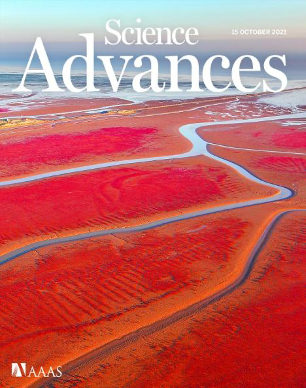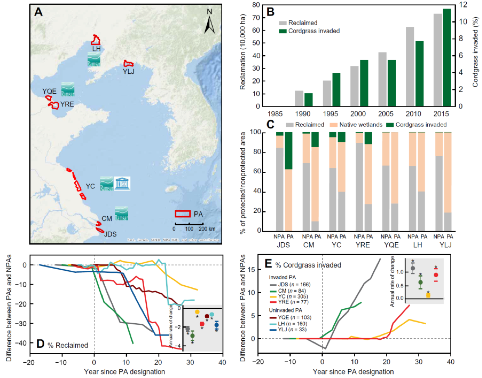Establishing protected areas (PAs) is the key approach for biodiversity conservation worldwide. It is not only an important topic for the COP15 UN Biodiversity Conference, the first part of which concluded this month in southwest China’s Kunming, but also a key issue addressed in the Suggestions for Further Strengthening the Conservation of Biodiversity recently released by China.
Recently, a paper titled “An invasive species erodes the performance of coastal wetland protected areas” was published in Science Advances, a leading international journal, and was featured on its front cover. The research team was from the MOE Key Laboratory for Biodiversity Science and Ecological Engineering and National Observation and Research Station for Wetland Ecosystems of the Yangtze Estuary (Shanghai), Fudan University. It is the first study globally to reveal the impacts of exotic species invasions on the performance of PAs and their underlying mechanisms across large spatiotemporal scales.

The iconic “Red Beach” marshes dominated by the red native succulentSuaeda salsa—one of the world’s most visually stunning ecosystems before the invasion of Spartina alterniflora in China’s Yellow River Delta
By analyzing three decades of seven of the largest, oldest, and best-managed coastal PAs in China, including multiple World Natural Heritage and/or Wetlands of International Importance sites, this study assesses the impacts of Spartina alterniflora, an exotic species on the performance of PAs at large spatiotemporal scales.
It shows that although PAs are achieving success in rescuing iconic wetlands and critical shorebird habitats from once widespread reclamation, this success is counteracted by escalating plant invasions.

Seven of China’s largest wetland PAs along the Yellow Sea coastline have reduced wetland reclamation but are increasingly invaded by exotic plants.

Important shorebird habitats inside PAs are converted into a “green desert” avoided shorebirds following the invasion of Spartina alterniflora.
The results challenge the prevailing view that large, old, and well-managed PAs with adequate staffing should be able to resist biological invasions. It is widely believed that human activities make exotic species invasions worse, and that compared to PAs, non-PAs with stronger human disturbances and more open habitats are typically expected to be more vulnerable to exotic species invasions. In fact, however, many terrestrial and marine PAs include habitats vulnerable to exotic species invasion.
This study shows that increasing the number and area of global PAs is important but insufficient. Control of Spartina alterniflora invasions has been carried out in some PAs in China, including one at Chongming Dongtan in Shanghai. To succeed in an increasingly invaded world, the 2030 target for global PAs needs to incorporate a two-pronged approach that combines traditional protection and active control of exotic species invasions.
Professor He Qiang from Fudan University is the corresponding author, and his PhD student Ren Junlin the first author. Meanwhile, Professor Li Bo from Fudan University offered important advice for this study. Collaborators of this study included scientists at Duke University, Brown University, Royal Netherlands Institute for Sea Research, University of Canterbury, Beijing Normal University, Xiamen University, Nanjing University, East China Normal University and Aerospace Information Research Institute of Chinese Academy of Sciences.
Link to the paper: https://www.science.org/doi/10.1126/sciadv.abi8943
Presented by Fudan University Media Center





